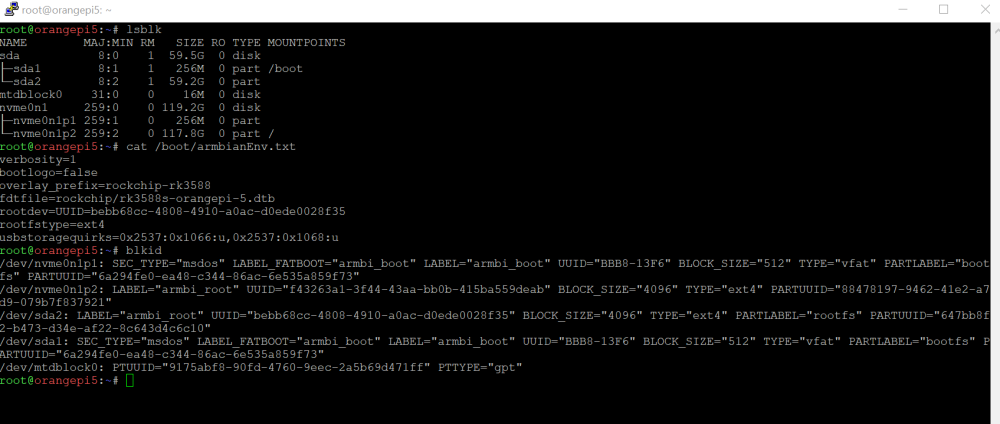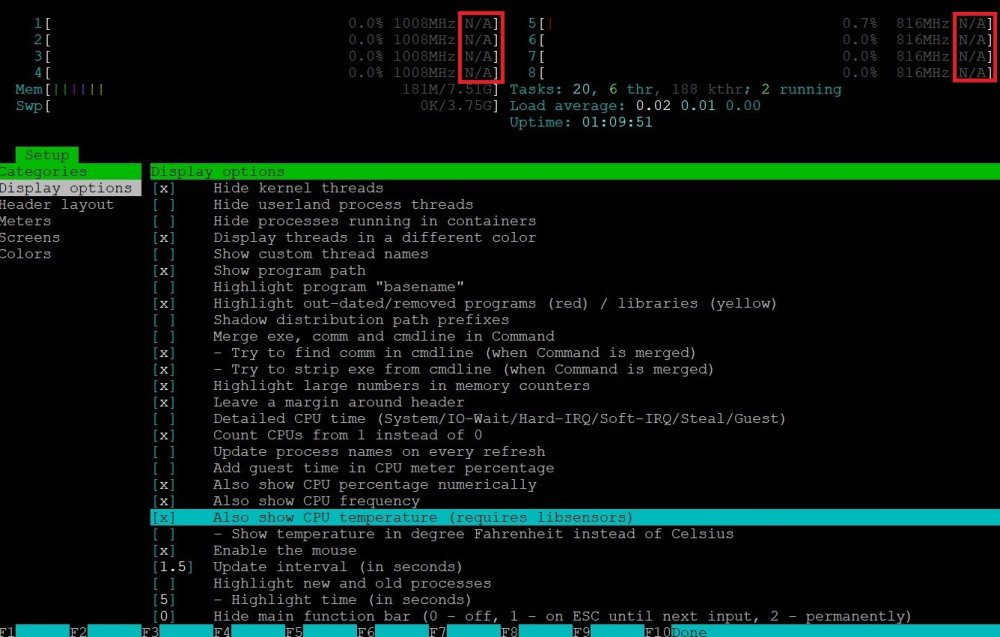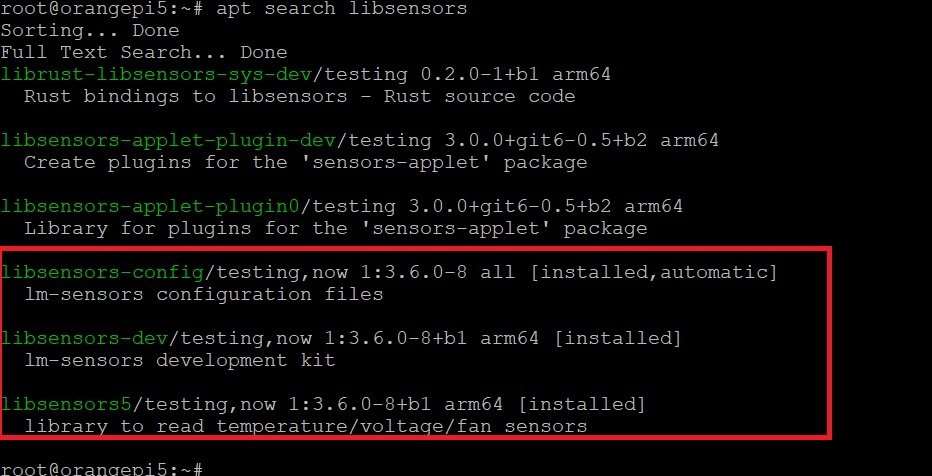Search the Community
Showing results for tags 'orangepi5'.
-
Kodi on Orange Pi 5 with GPU Hardware Acceleration and HDMI Audio Huge thanks to user @roykon the Armbian forums for the directions on this in their various forum posts and Armbian forum user @amazingfate for maintaining the PPAs and software builds required for GPU acceleration. I have simply listed below, for the reference of others, the minimum Steps used to get Kodi running with GPU hardware acceleration (for x264/x265 decode) plus HDR auto switching and with HDMI Audio output*. (I am using the Orange Pi 5 with a Samsung 4K TV) *No instructions added yet for enabling HDMI passthrough. ** No instructions added yet for enabling HDMI CEC. Step 1 (SD card image creation) Download the image below, uncompress it and write it to an SD card. https://github.com/armbian/build/releases/download/23.02.0-trunk.0173/Armbian_23.02.0-trunk.0173_Orangepi5_jammy_legacy_5.10.110_xfce_desktop.img.xz#orangepi5 Step 2 (First boot) Boot the SD card image and complete the on-screen prompts for user & password creation. Note down the IP address of the Orange Pi 5, you will need it in step 3. Step 3 (SSH into the Orange Pi 5) SSH to the IP address of your Orange Pi 5 and login using the user account and password you set up in Step 2. Step 4 (Enable PPAs and install other elements required for GPU hardware acceleration) At the command line, enter the following commands (highlighted in Blue): sudo add-apt-repository ppa:liujianfeng1994/panfork-mesa sudo add-apt-repository ppa:liujianfeng1994/rockchip-multimedia sudo apt update sudo apt full-upgrade sudo apt install ubuntu-desktop kodi When prompted on-screen if you wish to use gdm or lightdm, select gdm. Step 5 (Configuration file additions & changes) At the command line, enter the following commands (highlighted in Blue): sudo mv /usr/share/xsessions/kodi.desktop /usr/share/wayland-sessions/kodi-wayland.desktop sudo nano /etc/udev/rules.d/11-rockchip-multimedia.rules KERNEL=="mpp_service", MODE="0660", GROUP="video" KERNEL=="rga", MODE="0660", GROUP="video" KERNEL=="system-dma32", MODE="0666", GROUP="video" KERNEL=="system-uncached-dma32", MODE="0666", GROUP="video" RUN+="/usr/bin/chmod a+rw /dev/dma_heap" sudo nano /etc/gdm3/custom.conf Add the line below and save the file. WaylandEnable=true sudo nano /usr/share/alsa/cards/HDMI-OUT.conf Add all of the content below and save the file. # configuration for HDMI connection which just expose the # audio out device <confdir:pcm/hdmi.conf> HDMI-OUT.pcm.hdmi.0 { @args [ CARD DEVICE CTLINDEX AES0 AES1 AES2 AES3 ] @args.CARD { type string } @args.DEVICE { type integer } @args.CTLINDEX { type integer } @args.AES0 { type integer } @args.AES1 { type integer } @args.AES2 { type integer } @args.AES3 { type integer } type hw card $CARD } sudo nano /usr/share/alsa/cards/aliases.conf Add the line below and save the file. rockchip-hdmi0 cards.HDMI-OUT Step 6 (Reboot and Start Kodi) At the command line, enter the following commands (highlighted in Blue): sudo reboot At the login screen, select “kodi” in the bottom right hand corner menu. Now login using your username and password. Kodi should now load. Step 7 (Adjust Kodi settings) From within Kodi goto Settings -> Player -> Videos goto the bottom left corner of the screen and change it from Standard to Expert. From within Kodi goto Settings -> Player -> Videos, Playback, and change Adjust display refresh rate to “On start/stop” From within Kodi goto Settings -> Player -> Videos, Processing, enable "Allow using DRM PRIME decoder" and "Allow hardware acceleration with DRM PRIME". And set "PRIME Render Method" to "Direct To Plane" From within Kodi goto Settings -> System -> Display, and change the resolution to 1920x1080p From within Kodi goto Settings -> System -> Audio, and change the Audio output device to “Built in Audio Digital Stereo (HDMI),HDMI / DisplayPort (PULSEAUDIO)” Step 8 (Test video playback and check that GPU acceleration & HDMI Audio are working) During video playback, press ‘o’ on the keyboard, and it should show Video decoder: ff-hevc_rkmpp-drm_prime (HW) During video playback, if you have a Samsung TV, press the “Info” button on your Samsung TV remote to show the current playback resolution, frame rate and whether or not HDR is in use. (Depending on the video content being played) Thank you again to Armbian forum users @royk and @amazingfate
-
When using my (intel) laptop I get when I check my nvme (as root): # lspci -vvvs 01:00|grep -E "ASPM|L1" DevCap: MaxPayload 512 bytes, PhantFunc 0, Latency L0s <1us, L1 unlimited LnkCap: Port #0, Speed 16GT/s, Width x4, ASPM L1, Exit Latency L1 <8us ClockPM- Surprise- LLActRep- BwNot- ASPMOptComp+ LnkCtl: ASPM L1 Enabled; RCB 64 bytes, Disabled- CommClk+ Capabilities: [900 v1] L1 PM Substates L1SubCap: PCI-PM_L1.2+ PCI-PM_L1.1+ ASPM_L1.2+ ASPM_L1.1- L1_PM_Substates+ L1SubCtl1: PCI-PM_L1.2- PCI-PM_L1.1- ASPM_L1.2- ASPM_L1.1- L1SubCtl2: T_PwrOn=500us With the 6.1-vendor kernel I got the same on my rock05b and I did see others writing similar results (for example with the FriendlyElec Nanopi R6). With the 6.10-kernel I get: # lspci -vvvs 01:00|grep -E "L1,ASPM" <no output> Further searching yields "Unknown header type 7f". Is this typical for the 6.10-kernel or is this a bug in the armbian-kernel specific? The other problem with the 6.10-armbian kernel is that if I change a tiny option in the kernel config it yields a non-booting kernel (without changing the config the kernel does not compile, but is downloaded instead). This means I have the choice between a kernel I cannot compile myself and a vendor kernel without GPU acceleration (which I can compile). The 6.10-kernel should be more open, but without being able to boot a selfcompiled kernel I find it very closed. Is there any hint to get a selcompiled kernel booting?
-
for some strange reason the content of armbianEnv.txt (rootdev) is not applied in my opi5, if anyone can help me. Thank !!!
-
When I turn my Orange Pi 5 on, it auto-logins to the desktop which I do not want. I tried looking at nodm and lightdm but couldn't find either. I would like to disable this as it is a security concern. On a side note, as a feature request, this should be disabled by default or else something prompted for during the first time setup.
-
Hi everyone and thank you in advance for your support! Long story short my system is in Read only mode after a reboot and I don't know what caused it. Some useful info before the reboot: I've been trying to install a RAID1 configuration so at certain point I did sudo update-initramfs -u I have manually updated and upgraded (only busybox was upgraded) with sudo apt update && sudo apt upgrade If you need any other info let me know! EDIT: I found out that I'm able to manually mount the root partition, but the problem persist after each reboot. I then added the follong to /boot/armbianEnv.txt extraargs=fsck.mode=force fsck.repair=yes and touch /forcefsck and tried a reboot but nothing changes. It seems that there are some errors in the boot partition and this leads it to go Read-only
-
Armbian 24.5.1. I don't have a serial console setup so I can't tell if it's actually starting to boot or not, but it never gets to the point where a video signal is sent to HDMI. It *does* send a CEC on signal to the TV, which does turn on, and power-cycling the Pi then begins a normal boot process. Pi also boots normally headless. Problem noted on one Insignia model and on a Vizio TV, works as expected on another Insignia model, on a Hisense and on an LG. Issue began after updating the kernel from legacy.
-
hai, im planning to upgrade my local media server to use an external hard drive attached using hard drive docking on USB 3.0 what I'm confused about is. what is the best FileSystem format for my hard drive? I'm not planning to unmount and use the hard drive to another PC (for example: windows PC) So I'm ready to format it with FileSystem that fully optimizes on Linux (I'm using armbian noble) so ext4 or xfs? I hear xfs is better for copying large file sizes. my casual use is downloading movies, and watching it on jellyfin. or maybe I'm just using ext4?
-
I am creating the image from source from the Armbian build repository on GitHub for an Orangepi5. I have altered the kernel configuration to force module signing. The .config is attached. My problem is that after the build there is no signing_key.pem in /certs. But when I get the source from Torvalds repository and not using Armbian build the file gets created. The following helps to realize the scope of my question: https://www.kernel.org/doc/html/v6.1/admin-guide/module-signing.html#generating-signing-keys .config
-
Hello Is it possible to install emby server in Orange Pi5? Thanks
-
Hi all, has anyone ever tried to use an atomic firmware upgrade system like rauc or swupdate? https://rauc.readthedocs.io/en/latest/ https://sbabic.github.io/swupdate/swupdate.html I am playing with rauc, in order to do that I have to customize the partitioning of the SD/eMMC: - root1 (4GB) - root2 (4GB) - data (8GB, or remaining space) Can someone suggest how to customize partitioning in such way? I played around setting USE_HOOK_FOR_PARTITION=yes, and hooking the create_partition_table but had no luck. Any hint? Thanks in advance! Andrea
-
I upgraded my 5.10 install to 6.1 kernel got everything working including wifi using armbian-config - change kernel but after I noticed that video acceleration was broken with vlc I decided to rollback. The initial rollback somehow failed, after some tweaking, I've been able to boot the system again and run kernel 5.1 but now I don't have my ap6275 working anymore and the video acceleration modules from 5.x seem to be gone. I have the overlay for the ap6275 but it is not loading any module. What am I missing?
-
Ubuntu Noble had some early day issues with default key ring not being stored properly and or synced to the logged in user and users getting popup prompts about the default keyring locked. A week ago I downloaded Armbian Noble 25.5.2 desktop onto my OPi5. It has been my daily driver for the past week or so. It has been a really nice release for my OPi5. All has been good except the default keyring popups. I have created new users, deleted stored keyrings, changed passwords among other things. At this point I am able to store the default keyring password (which is the same as my login PW). However, when launching chromium, and ProtonVPN, I am still getting a keyring login prompt when launching either one of these apps. Looking at the Ubuntu Noble bug reports, it seems this was a Gnome issue that was fixed. When doing an update it seems there are a couple of Gnome updates being held back because they are "phased". Just wondering if wondering if the keyring issue is addressed in these held back updates? This is a minor annoyance. If the held Gnome update contains a solution, I will stop looking for a solution and wait for the updates to be released. Thanks TC
-
Orange Pi 5 Pro 16GB Armbian Ubuntu 24.04 XFCE on NVMe (SD card to boot to NVMe) USB 3.0 is not working anymore after install. Was working on OPi OS Ubuntu 22.04 before as I used it to copy Armbian image to NVMe. Logs shows nothing when connecting / removing cable, boot log has no mention about USB 3.0 and no power delivered. Is there some known setting, e.g. USB in OTG mode or something that can do this?
-
Is there any reason why orage pi5 pro minimal debian image is missing on download page?
-
I didn't know where to put this, but there is no forum for Orange Pi 5 Pro?
-
I'm trying to use a TP-Link tl-wn722n with AR9271 chipset, but it only shows up in lsusb: There is no such device in "ip a" or "iw list". I have enabled orangepi-5-ap6275p in armbian-config and full firmware package. Also installed the "firmware-ath9k-htc" package, but nothing helps. "modprobe ath9k_htc" returns that there is no such module.
-
Dear All, I have a USB wifi device that has always been working fine at boot with linux 5.1, now I upgraded to 6.1 gnome/vendor and I got a strange behavior on my OPI 5: - If I have wifi device plugged and power on the PI5, the USB device is not seen (no trace of it with lsusb). - If I have wifi device plugged and power on the PI5, the USB device is not seen (no trace of it with lsusb). But, with the PI 5 still running, If I unplug it and re-plug it, it is recognized and works fine. Also after that, if I issue a sudo reboot, the wifi device will be seen and work properly. (it does not matter what usb port I use white, or blue, same behavior on all) - If I plug the usb device on an external usb hub (with no external power source) with the USB-C and power On the PI5 the wifi usb is recognized at boot and works fine. What could this be due? Regards,
-
Hello, I'm a newby in linux and armbian. I'm trying to force static ip on my sbc, I followed some hints on internet adding file to interface.d folder, directly in interface file (both created on purpose by me). Interface is enP4p65s0 and I replaced in exaples eth0 with this (auto enP4p65s0 iface... etc) but it seems none works. armbian-config seems to do nothing (it seems broken) Anyone can route me to some doc?
-
I searched & tried all materials I can find, trying to set up FFmpeg to work with hardware acceleration on Orange Pi 5. But it did NOT work. Anyone else succeeds in using GPU hardware acceleration to encode/transcode video on Orange Pi 5 using FFmpeg? (or using gstreamer?) Could you please share with me the way to do it? Thank you very much indeed!
-
After upgrading to kernel 6.8, I've noticed my orange pi 5 running a bit hotter than when using kernel 5.10, even with the CPU load a little bit lower than before. Nothing alarming, just an observation. Did anyone else notice the same behaviour?
-
If someone is interested can easy setup OledStats for OrangePi5 and SSD1306 Hardware: Orangepi5 SSD1306 OLED display Software Armbian Jammy KDE Neon 6.1.43 Files attached in ZIP archive device.py PixelOperator.ttf setup.py stats.py How to: 1) add overlay wget https://raw.githubusercontent.com/orangepi-xunlong/linux-orangepi/orange-pi-5.10-rk3588/arch/arm64/boot/dts/rockchip/overlay/rk3588-i2c5-m3.dts sudo armbian-add-overlay rk3588-i2c5-m3.dts reboot 2) connect OLED display to I2C5 M3 Pins SDA + SCL (pins 1(VCC),2(SDA),3(SCL) and 5(GND)) check connection sudo i2cdetect -y 5 must be detected 3c value 3) install needed libs sudo apt-get install i2c-tools python3-smbus python3-pip python3-dev python3-pil 4) download main karabek project git clone https://github.com/karabek/OrangePi-OLED cd OrangePi-OLED rename old setup.py mv setup.py setup_old.py 4) create new setup.py or copy from ZIP archive nano setup.py #!/usr/bin/env python from setuptools import setup setup( name="ssd1306", version="0.1.0", author="Richard Hull", author_email="richard.hull@destructuring-bind.org", description="A small library to drive an OLED device with either SSD1306 or SH1106 chipset", license="MIT", keywords="raspberry pi rpi oled ssd1306 sh1106", url="https://github.com/rm-hull/ssd1306", packages=['oled'], ) 5) Start setup.py sudo python3 setup.py sdist 6) copy generated folders to python3 dist packages sudo cp -r OrangePi-OLED/oled/ /usr/local/lib/python3.10/dist-packages/ sudo cp -r OrangePi-OLED/ssd1306.egg-info/ /usr/local/lib/python3.10/dist-packages/ 7) replace device.py file with file in ZIP archive in dist-packages oled folder cd /usr/local/lib/python3.10/dist-packages/oled mv device.py device_old.py 9) copy stats.py and font file PixelOperator.ttf from ZIP archive start stats.py file sudo python3 stats.py result should be same as on RPI device picture Orangepi5_OLED.zip
-
I purchased this board to use as a gaming station and, among the options, I'm using moonlight with sunshine to stream my steam to the room, which is working wonderfully well, but I'm having a problem. When pairing the control with Armbian, it is recognized as a joystick but I cannot use it in any way. I have two Sony Dualsense joysticks, I tested them both with cable and Bluetooth and the problem is the same. Can anyone guide me where I can start to debug the problem? NOTE: I borrowed an IPEGA joystick and it worked normally. [ 1107.997887] playstation 0005:054C:0CE6.0007: unknown main item tag 0x0 [ 1107.998309] playstation 0005:054C:0CE6.0007: hidraw3: BLUETOOTH HID v1.00 Gamepad [DualSense Wireless Controller] on 00:1a:7d:da:71:13 [ 1108.025139] input: DualSense Wireless Controller as /devices/platform/usbdrd3_0/fc000000.usb/xhci-hcd.11.auto/usb7/7-1/7-1:1.0/bluetooth/hci0/hci0:71/0005:054C:0CE6.0007/input/input22 [ 1108.025917] input: DualSense Wireless Controller Motion Sensors as /devices/platform/usbdrd3_0/fc000000.usb/xhci-hcd.11.auto/usb7/7-1/7-1:1.0/bluetooth/hci0/hci0:71/0005:054C:0CE6.0007/input/input23 [ 1108.026601] input: DualSense Wireless Controller Touchpad as /devices/platform/usbdrd3_0/fc000000.usb/xhci-hcd.11.auto/usb7/7-1/7-1:1.0/bluetooth/hci0/hci0:71/0005:054C:0CE6.0007/input/input24 [ 1108.027180] playstation 0005:054C:0CE6.0007: Cannot register multicolor LED device [ 1108.027219] playstation 0005:054C:0CE6.0007: Failed to create dualsense. [ 1108.217580] playstation: probe of 0005:054C:0CE6.0007 failed with error -22
-
Hello, I am trying to create a custom uboot using armbian. it's possible? I am using the following command but I cannot generate the "uboot.bin" to save it to the spi: ./compile.sh uboot-config BOARD=orangepi5 BRANCH=current BUILD_DESKTOP=no BUILD_MINIMAL=yes BUILD_ONLY=u-boot CONFIGURATION=stable KERNEL_CONFIGURE=no KERNEL_ONLY=no PROGRESS_DISPLAY=plain RELEASE=bookworm UBOOT_ONLY=yes Thank.
-
Hello friends, htop does not show me the temperature, I am attaching information about my system (I have the libsensors library installed). If someone can help me please. Thank you. OS: Armbian 24.5.0-trunk.89 trixie aarch64 Host: Xunlong Orange Pi 5 Kernel: 6.8.0-rc1-edge-rockchip-rk3588 Uptime: 1 hour, 14 mins Packages: 333 (dpkg) Shell: bash 5.2.21 Terminal: /dev/pts/0 CPU: (8) @ 1.800GHz Memory: 187MiB / 7687MiB









